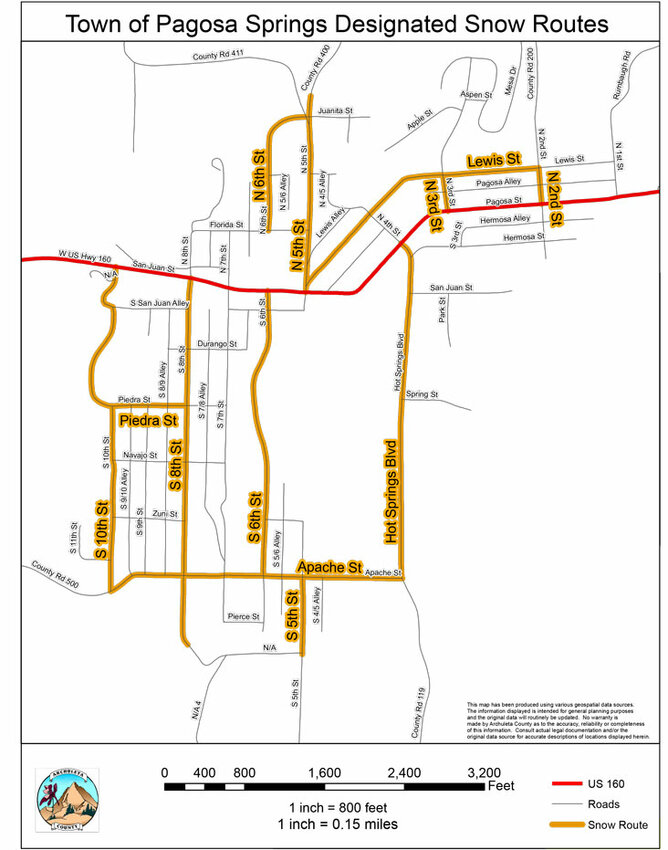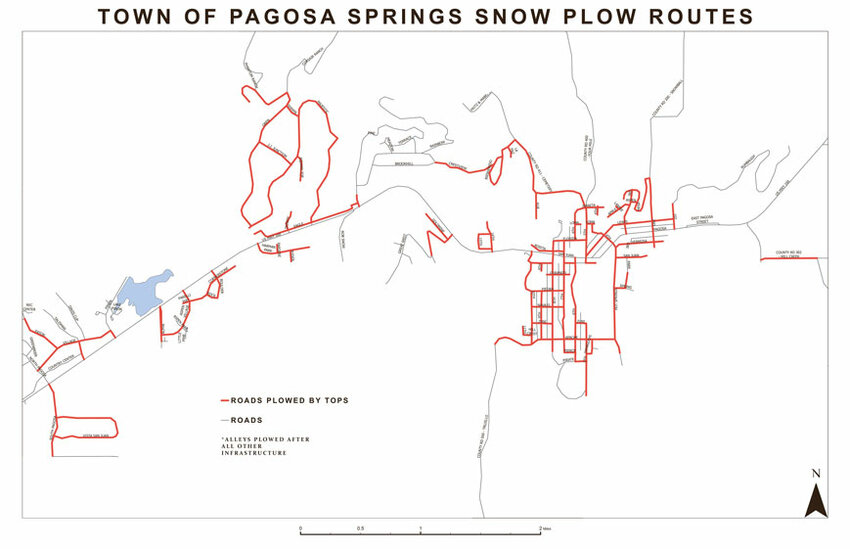
By Randi Pierce | Staff Writer
With snow in the forecast for Pagosa Country, local officials are gearing up to remove that snow to allow for safer travel.
Following are snow removal guidelines for residents and business owners in the Town of Pagosa Springs and Archuleta County, as provided by each entity.
More information can be found on each entity’s website.
Town of Pagosa Springs
The Town plows about 30 miles of streets and roads in the winter. Snow plowing begins when there are 2 inches of accumulation or road safety concerns.
The time required to clear snow and ice from roads varies depending on the conditions, including the storm intensity and duration, water content of the snow, temperature, traffic conditions and time of day. Because of those reasons, the Town may not be able to plow or sand roads at the same time each day or on the day of the storm.
The town has adopted designated snow routes with signage, and parking along designated snow route streets is prohibited during and immediately after snow events. Violators will be fined and/or towed at the owner’s expense. The snow route is effective through the last snow event of the season.
Other than streets, the town removes snow from pedestrian infrastructure around town facilities and abutting or adjoining parks and trails owned or leased by the town, provided that such areas are designated by the Pagosa Springs Town Council.
Resident, business owner, and snowplowing contractor responsibilities
It is unlawful to push or throw snow onto or across streets or alleys, or to put snow on any public property or right of way; plowed, shoveled or blown snow must be disposed of on your own property.
It is the property owner’s or business owner’s responsibility to provide snow and ice removal on sidewalks abutting their property within 24 hours of the end of snowfall. This applies when there is an accumulation of 1 inch or more.
Do not use ice melt on concrete. Damage from chemical or mechanical removal of snow is the responsibility of the property owner.
Consistent snow removal and mitigating slip hazards without the use of chemicals is the best for the concrete and roads. Add grit for traction if necessary.
Trash carts should be placed in the driveway, a minimum of 5 feet behind the front of the snow berm to minimize the possibility of being knocked over. Trash carts knocked over by snow removal efforts are the resident’s responsibility.
It is the resident’s responsibility to remove the snow berm left from street plowing and trail plowing. Reasonable efforts will be made to minimize the berm left behind.
Other information
Do not park along snow routes. Parking problems are compounded by winter snow.
Parking along U.S. 160 between 2 a.m. and 6 a.m. is prohibited. This includes through downtown.
Do not attempt to stop a snowplow or obstruct its path. Plows must maintain speed for maximum efficiency.
When approaching a snowplow from the rear, follow at a minimum distance of 100 feet, allowing for the scattering of sand and for abrupt movements.
Be patient. Every reasonable effort will be made to keep roadways open, and all available personnel will be on the road during major snowstorms.
Ask permission before moving snow onto a neighbor’s property, snow should remain on your property in almost every case.
Town residents with questions concerning snow removal can contact Debbie Allen at 264-4151, ext. 400.
Archuleta County
The county plows approximately 340 miles of roads in the winter.
County roads are categorized on a priority basis and the roads with higher priorities are plowed first, such as school bus routes. Remaining roads are plowed based on priority and route efficiencies.
Snow-removal crews normally begin clearing roads at 2 a.m. if necessary, but crews may not clear lower-priority roads the day of the storm. Weekend and extended-shift plowing may take place under the direction of the public works director when deemed appropriate.
Hills are sanded for safety as required.
Typically, plowing operations begin when there is snowfall accumulation in excess of 4 inches. On days without snow, crews will clean up and push back snowbanks as needed.
Under extreme circumstances, county roads may not receive same-day snow removal. Only first-priority roads will be plowed and kept open on excessive snow days.
Schedules may be interrupted or postponed due to unpredictable or unusual weather conditions, emergency situations, safety and resources.
Types of plowing operations
There are usually two types of snow-removal operations.
The first occurs during the storm and consists of passes with the plows to keep the roads open. This includes clearing a path sufficient for two vehicles to pass and clearing cul-de-sacs enough to allow a vehicle to turn around.
The second performs cleanup and preparation for the next snowfall.
Secondary work begins when the storm subsides and consists of widening the traveled portion of the road, pushing snow back and plowing out wider areas on the roadways.
It may be several days between the first and second plowing.
Driveway and access
road snow berms
Snowplowing operations may result in a berm across private driveways or encroachments to county roads. Reasonable efforts will be made to minimize the snow that is deposited in front of driveways, but berm removal is the responsibility of individual property owners.
County personnel also caution property owners to avoid piling snow on the left side of their driveway (as looking from your garage toward the road) to avoid having a larger berm.
Instead, he suggested cutting a notch 3 feet wide from the edge of the road by 30 feet long to minimize the size of the berm left behind by the plow.
Safety concerns
Children playing in the snowbanks left by the plow equipment is a major safety concern. Machines can be pushing back snowbanks at any time. Avoid tragedies and inform your children that building snow caves and playing on the berms is dangerous.
Other information
Property owners who create hazards in a public right of way, such as plowing snow off private drives, piling construction materials or timber, or placing trash carts, may be subject to prosecution per state statute.
A property owner may also be liable for any injury attributable to a hazard they have created in a public right of way.
Parking on county roads during winter inhibits plowing and is prohibited along all county roads and within any county right of way. Vehicles in the roadway during snow-removal operations will be towed at the owner’s expense.
The county’s Model Traffic Code, adopted in recent years, makes it easier to have vehicles towed that are parked on county roads, with the county announcing last year it would more strictly enforce the prohibition.
Homeowners and contractors are cautioned that pushing snow across a county road at any time can create hazards and are advised not to do so. Per statute, it is unlawful for any person to deposit snow plowed from a private driveway, road or other source onto county road rights of way.
Trash carts should be placed in the driveway a minimum of 5 feet behind the front of the snow berm to minimize the possibility of being knocked over. The county is not responsible for trash carts that are knocked over.
Driving safety around snow equipment
Slow down and use caution around snow-removal equipment.
Follow at a safe distance to avoid flying snow and sanding material.
Stay out of the equipment’s blind spots.
Turn your headlights on.
Flashing blue lights on a truck indicate an emergency vehicle and it is illegal to pass.
Use extreme caution when passing snow-removal equipment. Before you pass, honk your horn and flash your lights to alert the operator you intend to pass.
Equipment operators often work long hours under trying conditions; be a courteous and friendly driver around them.
Helpful phone numbers
Emergencies: 911.
Archuleta County Combined Dispatch: (970) 731-2160.
Archuleta County Road and Bridge: (970) 264-5660.
Archuleta County Sheriff’s Office: (970) 264-8430.
Pagosa Springs Police Department: (970) 264-4151, ext. 228.
Town of Pagosa Springs: (970) 264-4151.
Road and weather information: (970) 264-5555.
